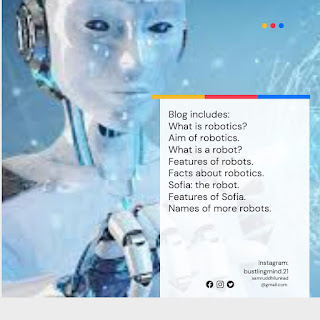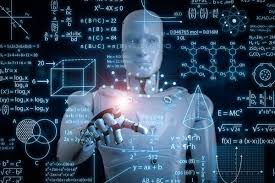Robotics and Sophia
Robotics is an area of computer science and engineering that is multidisciplinary. Robotics is the study of the design, manufacture, operation, and use of robots. Robotics aims to create devices that can support and benefit people. Mechanical engineering, electrical engineering, information engineering, mechatronics, electronics, bioengineering, computer engineering, control engineering, software engineering, mathematics, and other subjects are all included in robotics. Robotics is the study of creating devices that can take the place of people and mimic their behaviors. Robots can be employed in a variety of scenarios and for a variety of objectives, but many are now utilized in hazardous areas (such as radioactive material inspection, bomb detection, and deactivation), manufacturing operations, or in conditions where humans are unable to live (e.g. in space, underwater, in high heat, and clean up and containment of hazardous materials and radiation). Robots may take on any shape, but some are designed to seem like people. This is said to aid robot adoption in certain replicative activities that are normally performed by humans. Walking, lifting, speaking, cognition, and any other human behavior are all attempted by these robots. Many of today's robots are influenced by nature, making bio-inspired robotics a growing area.
Robotics is the combination of science, engineering, and technology that results in devices called robots that replace (or imitate) human actions. Robots have long been a source of fascination in popular culture. R2-D2. Prime, Optimus. WALL-E. These exaggerated, humanoid robot designs sometimes appear to be a parody of the actual thing...or are they more forward-thinking than we realize? Robots are increasing intellectual and mechanical skills, implying that an R2-D2-like machine is not out of the question in the future.
A robot is a product of the robotics sector, which involves the creation of programmable robots that can aid people or duplicate their operations. Robots were originally designed to perform repetitive activities (such as making vehicles on an assembly line), but they have since evolved to accomplish duties such as fighting fires, cleaning houses, and aiding with extremely complex procedures. Each robot has a different amount of autonomy, ranging from fully-autonomous bots that accomplish activities without any external influences to human-controlled bots that carry out tasks that a person has complete control over.
The breadth of what is called robotics expands as technology advances. In 2005, 90 percent of all robots were working in auto manufacturers, building vehicles. These robots mostly comprise mechanical arms that are charged for welding or screwing on certain automotive parts. Today's concept of robotics has grown and expanded to encompass the development, construction, and deployment of bots that explore Earth's harshest environments, robots that aid law enforcement, and even robots that assist in practically every aspect of healthcare.
While the field of robotics as a whole is growing, there are several features that all robots share:
1. Every robot is made up of some form of a mechanical component. A robot's mechanical aspect aids it in completing duties in the environment for which it was created. The wheels of the Mars 2020 Rover, for example, are independently powered and composed of titanium tubing, allowing it to securely grasp the hard surface of Mars.
2. Electrical components are required by robots to manage and power the machines. A huge majority of robots, in essence, require an electric current (for example, from a battery).
Facts about robotics-
1. The term "robot" is derived from the Czech word "robota," which means "drudgery," and was first used in the 1921 drama R.U.R. (Rossum's Universal Robots). When the machines rise up and slaughter their creators, the story comes to a climax, leaving only one lone survivor.
2. It was said to be an accident. In 1981, a robotic arm crushed a Japanese Kawasaki industrial worker, which was the first recorded occurrence of robot murder. 3 More than a million industrial robots are currently in operation, with Japan accounting for roughly half of them.
3. George Devol was the first to create a digitally controlled robot.
4. A robot is a machine that is programmed to do activities without the assistance of a human.
5. Robots only do what is programmed into them.
Sophia: the robot
Hanson Robotics, located in Hong Kong, created Sophia, a social humanoid robot. Sophia was awakened on February 14, 2016, and made her first public appearance in mid-March 2016 at the South by Southwest Festival (SXSW) in Austin, Texas. Sophia has been featured in several high-profile interviews and has been covered by the media all around the world. Sophia "became" a Saudi Arabian citizen in October 2017, making her the world's first robot to do so. Sophia was appointed the United Nations Development Programme's first ever Innovation Champion in November 2017, making her the first non-human to receive any UN title.
Features of sofia:
Sophia can see due to cameras in her eyes and computer algorithms. She can follow people's faces, maintain eye contact, and identify them. A natural language subsystem allows her to process speech and converse. Sophia was given functioning legs and the capacity to walk in January 2018. Sophia's "lifelike" complexion and ability to imitate over 60 facial emotions have been praised by CNBC. Sophia is theoretically related to ELIZA, a computer software that was one of the earliest efforts to simulate human dialogue. Like a chatbot, the software is trained to respond to certain inquiries or phrases with pre-written replies. Sophia, according to David Hanson, would be a fantastic fit for roles in healthcare, customer service, therapy, and education. Sophia demonstrated her abilities to draw, including portraits, in 2019.
Names of more such robots like sofia:
Alice, Albert Einstein Hubo, BINA48, Han, Jules, Professor Einstein, Philip K. Dick Android, Zeno, and Joey Chaos are the robots made by Hanson.
If you enjoyed reading my blog, please share it with your friends and family. You may also read some of my previous posts. Keep smiling and have a wonderful weekend.









